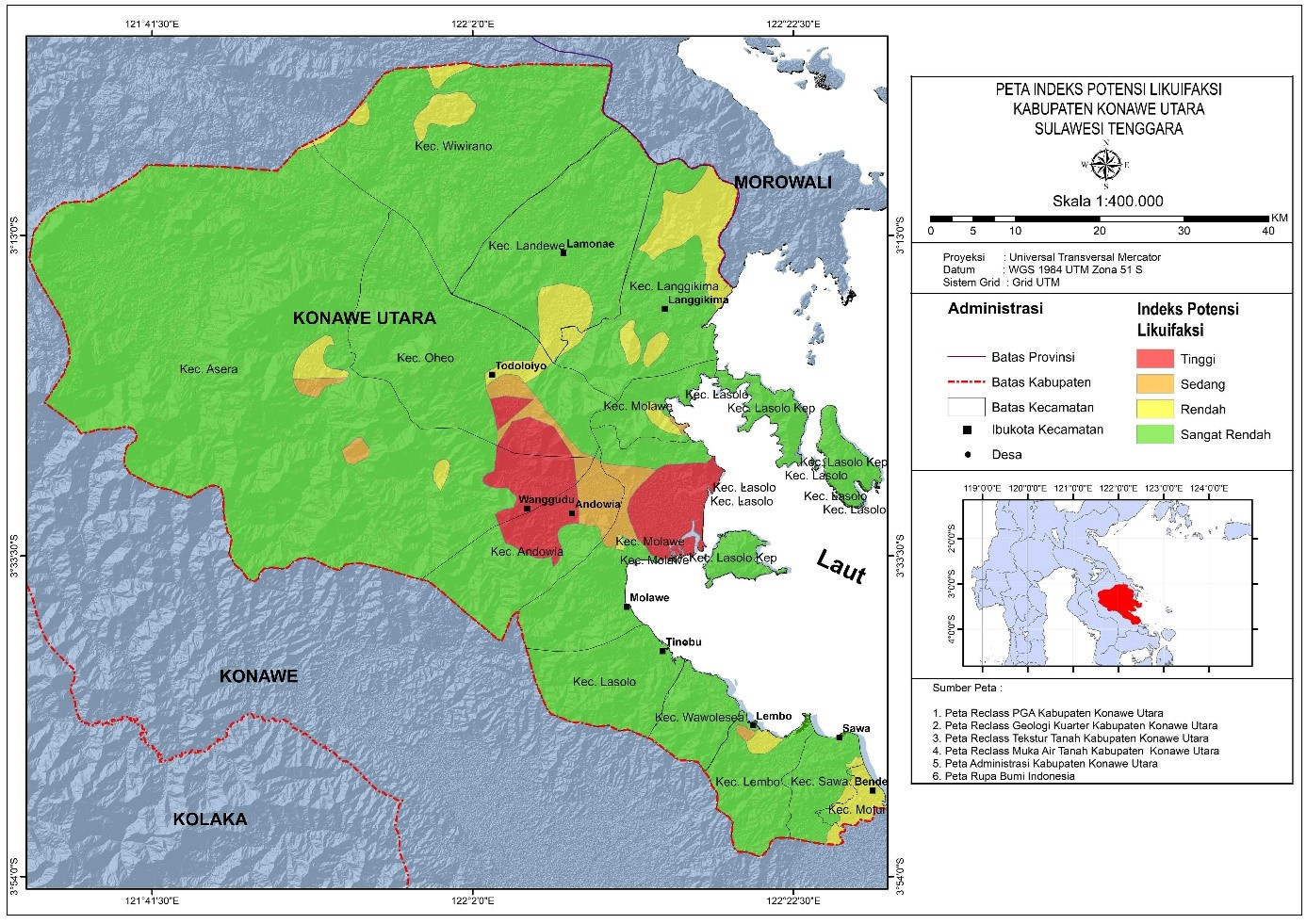Potensi Likuifaksi Di Kabupaten Konawe Utara Sulawesi Tenggara Berdasarkan Metode Susceptibility Rating Factors (SRF)
DOI:
https://doi.org/10.56099/ophi.v6i1.p11-18Keywords:
likuifaksi, potensi, indeks suseptibilitas, Konawe UtaraAbstract
The liquefaction disaster that occurred in Palu, Central Sulawesi, was caused by a 7.5 SR. The movement of the Palu-Koro Fault triggered the earthquake which was then followed by liquefaction. North Konawe Regency, Southeast Sulawesi, is crossed by the Lawanopo Fault which is a continuation of the Palu-Koro Fault, so that North Konawe Regency has the potential for liquefaction. BMKG seismic data records that >90% of earthquake events in North Konawe are triggered by movements of the Lawanopo Fault. This research focuses on the potential for liquefaction that can be triggered by earthquake activity in North Konawe Regency. Susceptibility Rating Factor (SRF) method is used by calculating the liquefaction susceptibility index (ISL) based on historical parameters, geological data, soil texture and composition, and hydrogeological data. North Konawe Regency has 5% areas with high liquefaction potential, 2% medium potential, 6% low potential, and 87% very low potential. Areas with high potential (5%) and medium potential (2%) are densely populated areas because they are located in the center of the capital city of North Konawe Regency. This area is a basin formed due to the activity of the Lawanopo Fault.
References
Cilia, M. G., Mooney, W. D. & Nugroho, C. 2021. Field Insights and Analysis of the 2018 Mw 7.5 Palu, Indonesia Earthquake, Tsunami and Landslides. Pure and Applied Geophysics, 178(12), pp. 4891-4920. https://doi.org/10.1007/s00024-021-02852-6
Dinata, I. A., Darlan, Y., Sadisun, I. A., Pindratno, H. & Saryanto, A. 2016. Liquefaction hazard analysis for infrastructure development in gulf of Jakarta. AIP Conference Proceedings, 1730(1). https://doi.org/10.1063/1.4947384
Green, R. A. & Bommer, J. J. 2019. What is the Smallest Earthquake Magnitude that Needs to be Considered in Assessing Liquefaction Hazard? Earthquake Spectra, 35(3), pp. 1441-1464. https://doi.org/10.1193/032218eqs064m
Idriss, I. M. & Boulanger, R. W. 2006. Semi-empirical procedures for evaluating liquefaction potential during earthquakes. Soil Dynamics and Earthquake Engineering, 26(2), pp. 115-130. https://doi.org/https://doi.org/10.1016/j.soildyn.2004.11.023
Iswanto, E. R., Syaeful, H. & Sriyana. 2017. Analisis Potensi Likuifaksi di Tapak Reaktor Daya Eksperimental Serpong Seminar Nasional Teknologi Energi Nuklir, Makassar. pp.
Jalil, A., Fathani, T. F., Satyarno, I. & Wilopo, W. 2021. Liquefaction in Palu: the cause of massive mudflows. Geoenvironmental Disasters, 8(1), pp. 21. https://doi.org/10.1186/s40677-021-00194-y
Kramer, S. L. 2008. Evaluation of Liquefaction Hazards In Washington State. Seattle: Washington State Department of Transportation.
Mase, L. Z. 2020. Seismic Hazard Vulnerability of Bengkulu City, Indonesia, Based on Deterministic Seismic Hazard Analysis. Geotechnical and Geological Engineering, 38(5), pp. 5433-5455. https://doi.org/10.1007/s10706-020-01375-6
Mase, L. Z. 2021. The Use of Ground Motion Parameters to identify the Liquefaction during a Strong Earthquake in Northern Thailand. 2021, pp. 8. https://doi.org/10.14710/mkts.v27i1.29218
Rusmana, E., Sukido, Sukarna, D. & Simandjuntak, E. H. T. 1993. Peta Geologi Lembar Lasusua - Kendari, Sulawesi. Bandung: Pusat Penelitian dan Pengembangan Geologi.
Surono & Hartono, U. 2013. Geologi Sulawesi. Jakarta, LIPI Press.
Triandys, R., Oktaviana, I. S. & Irdhiani, I. 2022. STUDI POTENSI LIKUIFAKSI PADA SEKITAR JALAN JAMUR KELURAHAN BALAROA KOTA PALU. Inersia: Jurnal Teknik Sipil, 14(1), pp. 41-53. https://doi.org/10.33369/ijts.14.1.%p
Widyaningrum, R. 2012. Penyelidikan Geologi Teknik Potensi Liquifaksi Daerah Palu, Provinsi Sulawesi Tengah. Bandung: Badan Geologi.

Downloads
Published
How to Cite
Issue
Section
License
Copyright (c) 2024 Rio Irhan Mais Cendra Jaya, Deniyatno

This work is licensed under a Creative Commons Attribution-ShareAlike 4.0 International License.















